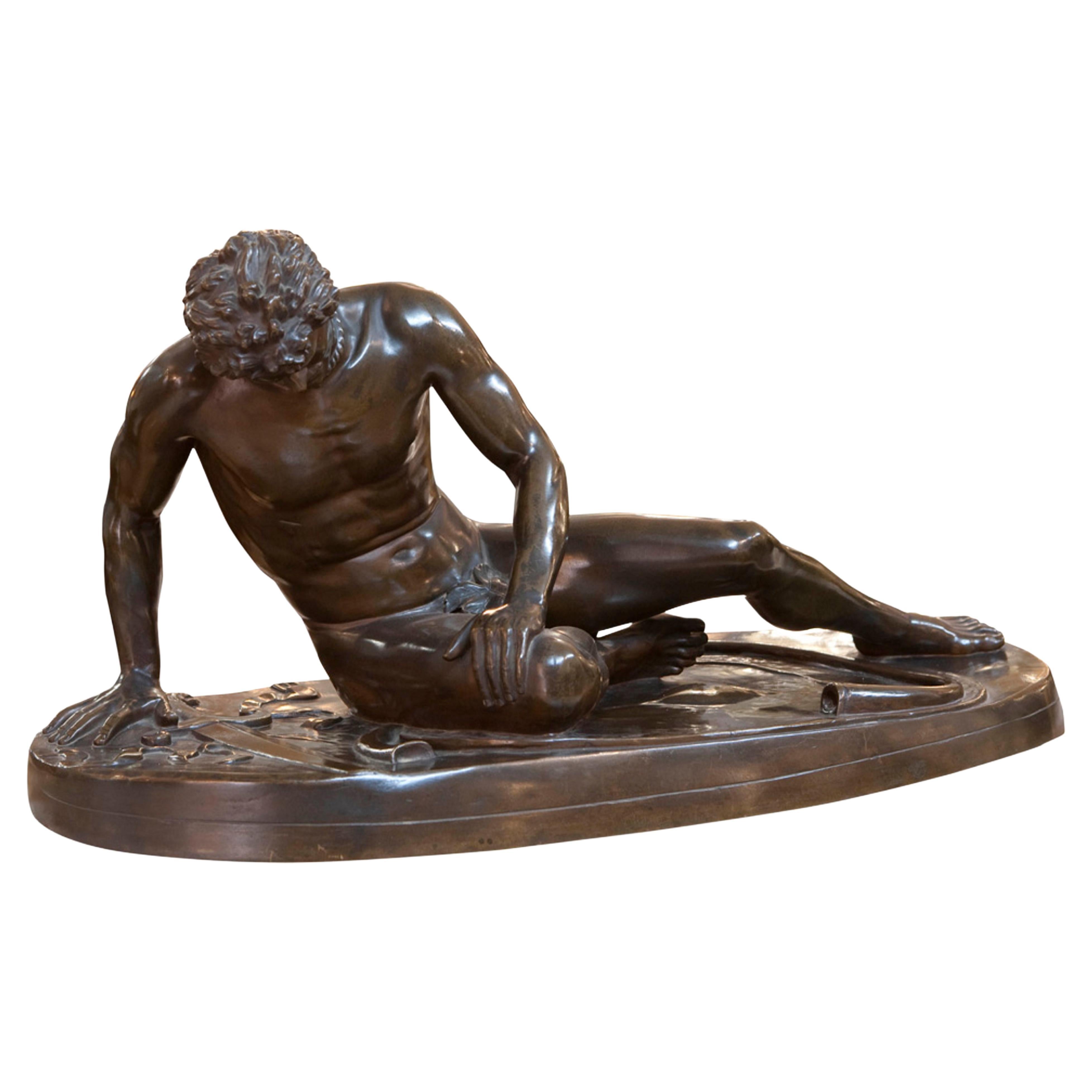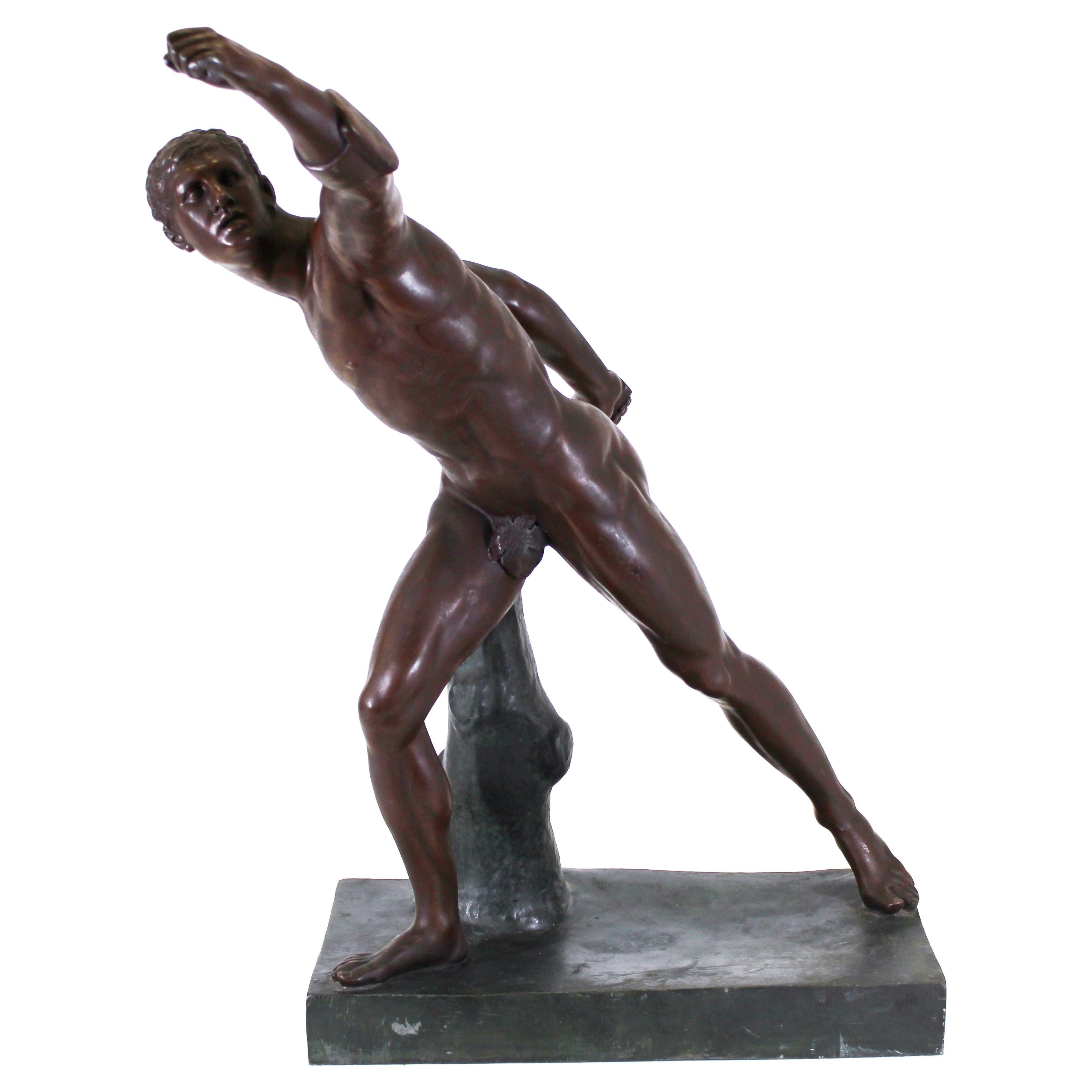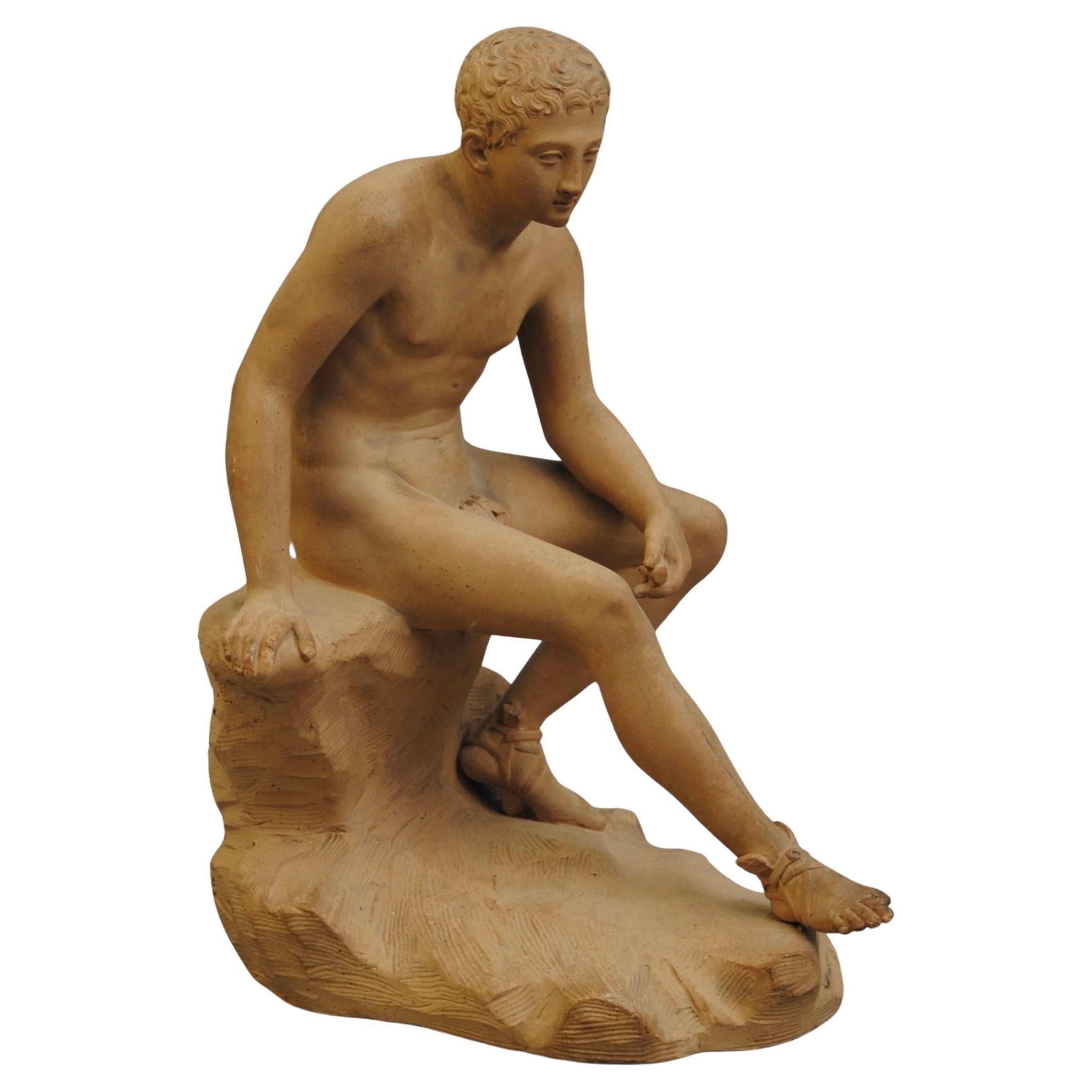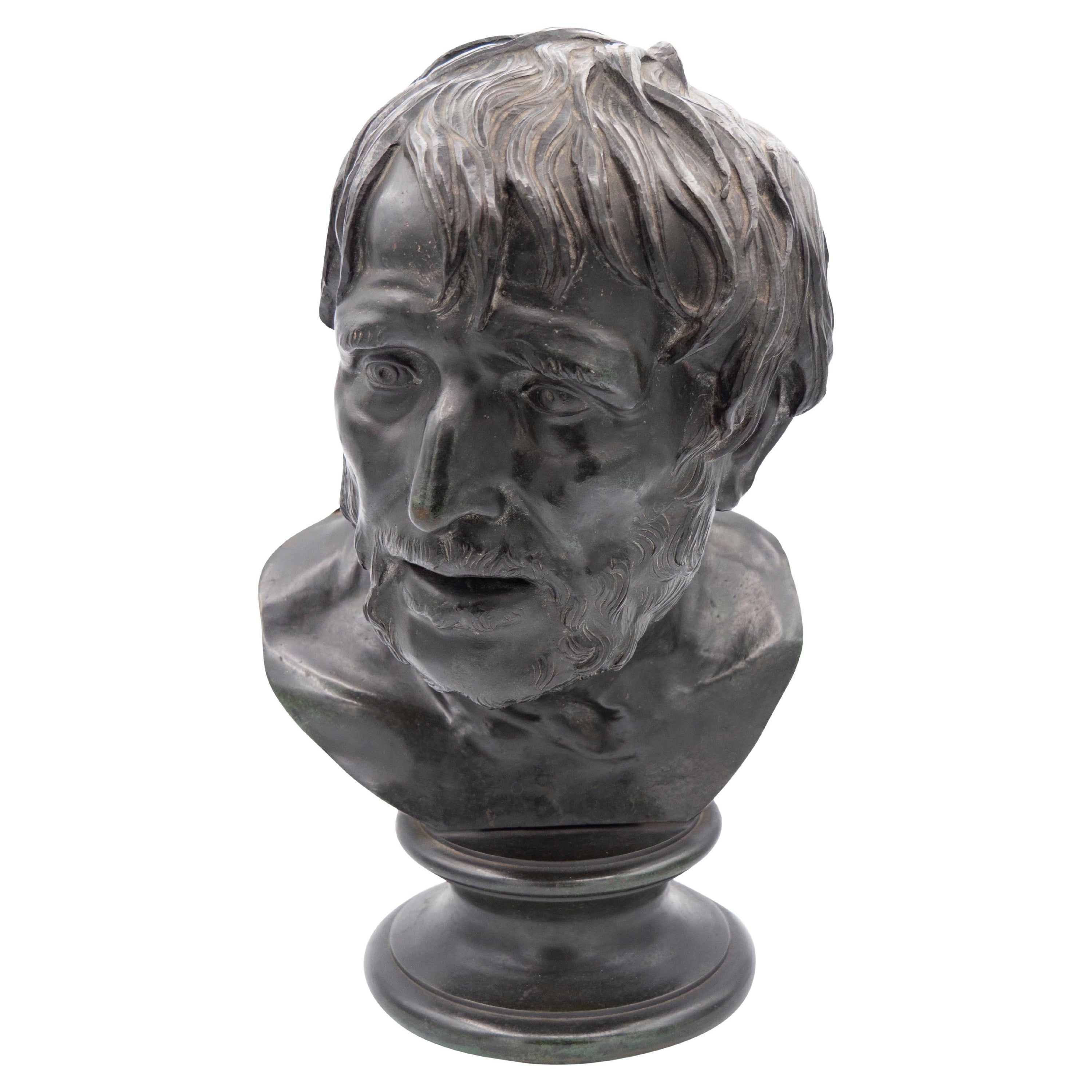Items Similar to Gladiatore Ferito Figura Grand Tour in Bronzo Ispirata al Galata Morente Romano
Video Loading
Want more images or videos?
Request additional images or videos from the seller
1 of 14
Gladiatore Ferito Figura Grand Tour in Bronzo Ispirata al Galata Morente Romano
About the Item
Gladiatore ferito in bronzo, scultura italiana della seconda metà del 1800 in buono stato di conservazione. La figura si ispira alla scultura ellenistica raffigurante il "Gallo morente" il celebre Galata Morente in marmo dei Musei Capitolini di Roma. L'opera è firmata da autore non identificato in quanto la firma presente sul bordo della base non è decifrabile, vedasi dettaglio fotografico. Si tratta della rappresentazione di un guerriero ormai vinto, un gladiatore con ferite sanguinanti da arma da taglio in una gamba e al petto che inginocchiato a terra, alza con una mano la spada con la lama spezzata, mentre con l’altra regge lo scudo.
La fusione è stata eseguita in terra ed ha una patina verde scuro; risale alla seconda metà del 1800 ed è in perfetto stato di conservazione. Sotto la base reca l’etichetta di un negozio veneziano. Questa scultura italiana trova la sua ragion d’essere in quelle che erano le proposte per i ricordi da viaggio del Grand Tour.
La esportazione dall'Italia è soggetta alle Belle Arti, una licenza governativa che va richiesta al ministero ed il cui rilascio necessita 2/3 settimane. La spedizione potrà essere effettuata solo con questa licenza.
- Dimensions:Height: 21.66 in (55 cm)Width: 21.66 in (55 cm)Depth: 12.21 in (31 cm)
- Style:Grand Tour (In the Style Of)
- Materials and Techniques:
- Period:
- Date of Manufacture:1880 circa
- Condition:
- Seller Location:Milan, IT
- Reference Number:
About the Seller
5.0
Vetted Seller
These experienced sellers undergo a comprehensive evaluation by our team of in-house experts.
Established in 1990
1stDibs seller since 2016
164 sales on 1stDibs
Typical response time: 1 hour
Associations
International Confederation of Art and Antique Dealers' Associations
- ShippingRetrieving quote...Ships From: Milan, Italy
- Return PolicyA return for this item may be initiated within 1 day of delivery.
More From This SellerView All
- Narcissus in Bronze Italian Grand Tour Sculpture According to the Model of PompeiiLocated in Milan, ITNarcissus Bronze Sculpture early 1900s, the figure is a reproduction from the classical-era bronze of the Greek god Dionysus found in the 1862 excavations at Pompeii and preserved a...Category
Vintage 1920s Italian Grand Tour Figurative Sculptures
MaterialsBronze
- Bambina in Bronzo Scultura Italiana Intitolata NIVES di Eugenio Pellini 1900By Eugenio PelliniLocated in Milan, ITEugenio Pellini Nives Primi 1900 fusione in bronzo a patina scura firmata dall’autore italiano lombardo E. Pellini (1864-1934) sul lato sinistro della base rettangolare; sul bordo frontale sempre in stampatello troviamo inciso il titolo, Nives, nome della figlia primogenita. In ottimo stato di conservazione, la scultura risale all’inizio Novecento e proviene da una collezione privata milanese. Appoggiata su di una base quadrata con un lieve incavo portaggetti nella parte anteriore, come fosse una scultura fermacarte, la bimba vestita con un camice ed una cuffia è ritratta intenta ad osservare un oggetto morbido, forse una bambola, che regge tra le mani. Per l'esportazione dall'Italia di un oggetto d'arte che risale a più di 50 anni di età, va richiesta al Ministero dei Beni Culturali una licenza di esportazione chiamata BELLE ARTI. il rilascio di tale licenza governativa richiede un paio di settimane circa, da aggiungere ai tempi di evasione dell'ordine. Eugenio Pellini nasce il 17 novembre 1864 a Marchirolo, a quei tempi in provincia di Como (oggi Varese) da Andrea e Carolina Pellini.Nel 1878 si trasferisce a Milano presso il fratello Oreste e inizia l’apprendistato nella bottega del marmista Biganzoli. Nel 1888 comincia a frequentare l’Accademia di Brera e realizza le prime opere significative, in particolare “Lo spazzacamino”. Il 10 novembre 1891 vince il Premio Triennale Oggioni, che prevede la specializzazione presso l’Accademia di Roma. Eugenio inizia così un lungo viaggio d’arte attraverso l’Italia, in un percorso che lo porterà a Firenze, Roma e in Sicilia. Successivamente, a Parigi incontra la scultura di Medardo Rosso e di Rodin, autori che risulteranno fondamentali per l’evolversi del suo stile. Torna a Milano nel 1893 e realizza alcune sculture monumentali come “L’angelo del dolore”per la tomba Macario e il “Cristo nel Getsemani”per la tomba Lardera. La consacrazione artistica si completa nel 1897 con la vittoria al Premio Tantardini, in cui propone l’opera “Madre”; con tale gruppo scultoreo viene chiamato a rappresentare la scultura lombarda all’Esposizione Universale di Parigi nel 1900, dove riceve altri premi. A causa delle agitazioni che interessavano Milano, lo scultore si rifugia a Varese. Ai primi anni del ‘900 ritorna Milano e ottiene l’incarico per l’insegnamento alla Scuola Superiore degli Artefici del Castello Sforzesco, attività che mantiene fino al 1929. Nel 1903, l’incontro con la futura moglie, Dina Magnani, modella all’Accademia di Brera, da cui avrà tre figli: Nives, Eros (futuro scultore) e Silvana. Partecipa a tutte le Biennali di Venezia, a partire dal 1905; è presente alla Secessione Romana, alla Triennale di Brera, a numerose mostre all’estero. Nel frattempo, la grave...Category
Early 20th Century Figurative Sculptures
MaterialsBronze
- Set of Four Grand Tour Etchings Italian Architectural Views Remondini circa 1770Located in Milan, ITA late-18th century Italian hand-colored copper engravings, original Italian etchings by Remondini, from Bassano dating back to 1770 circa. The set of four etchings...Category
Antique Late 18th Century Italian Grand Tour Prints
MaterialsWood, Paper
- 20th Century Grand Tour Pair of Italian Figurative Pen-Holders Desk AccessoriesLocated in Milan, ITA set of two lovely Grand Tour hand-painted terracotta figurative pen-holders of Neapolitan origin, molded as a male and female foreign tourists caricatures, British characters. Bot...Category
Early 20th Century Italian Grand Tour More Desk Accessories
MaterialsTerracotta
- Coppia di Vasi Italiani Impero in Bronzo con Manici Argentati a Forma di CignoLocated in Milan, ITCoppia di Vasi Impero in Bronzo con Anse a Cigno realizzati in Italia, inizio 1800, coppia di eleganti vasi da centro di gusto Impero, di forma circolare, su base squadrata, corpo im...Category
Antique Early 19th Century Italian Empire Vases
MaterialsBronze
- Winged Putto Italian Sculpture 1700 Face of Angel in Carved WoodLocated in Milan, ITWinged Putto Sculpture of Italian origin from the 1750s depicts the Face of Angel In Carved Wood from a liturgical ornament to which it was attached with two nails, holes can still ...Category
Antique Mid-18th Century European Rococo Figurative Sculptures
MaterialsPine
You May Also Like
- "Galata Morente" Sculpture in Bronze and Marble F. Barbedienne FonduerBy F. Barbedienne FoundryLocated in Ciudad Autónoma Buenos Aires, CWe have specialized in the sale of Art Deco and Art Nouveau and Vintage styles since 1982. If you have any questions we are at your disposal. Pushing the button that reads 'View All From Seller'. And you can see more objects to the style for sale. F. Barbedienne fonduer Ferdinand Barbedienne (6 August 1810 – 21 March 1892) was a French metalworker and manufacturer, who was well known as a bronze founder. The son of a small farmer from Calvados, he started his career as a dealer in wallpaper in Paris. In 1838 he went into partnership with Achille Collas (1795-1859), who had just invented a machine to create miniature bronze replicas of statues. Together they started a business selling miniatures of antique statues from museums all over Europe, thus democratising art and making it more accessible to households.[2] From 1843 they extended their scope by reproducing the work of living artists and also diversified by making enamelled household objects. With the outbreak of the Franco-Prussian war in 1870 the firm briefly had to switch to cannon founding owing to the shortage of metals but resumed business afterwards. Following Barbedienne's death in 1892, he was buried in the Père-Lachaise cemetery and the firm was carried on by his nephew Gustave Leblanc until 1952. Among the principal artists reproduced by the firm were Antoine Louis Barye and Auguste Rodin. The Dying Galata (Italian: Galata morente...Category
Antique 1870s French Classical Roman Figurative Sculptures
MaterialsBronze
- French Grand Tour Borghese Gladiator in Cast MetalLocated in New York, NYMonumental French late 19th century Grand Tour heavy cast metal sculpture of the Borghese Gladiator. The piece depicts a swordsman during fight and is a cast reproduction of the fame...Category
Antique 1880s French Grand Tour Figurative Sculptures
MaterialsMetal
- Grand Tour Terracotta Of MercuryLocated in Lincolnshire, GBAn Italian terracotta figure of Mercury resting on a rock after Giovanni Mollica - Mid 19th century Hand written label to the base see imageCategory
Antique Mid-19th Century Italian Grand Tour Figurative Sculptures
MaterialsTerracotta
- "Menelaeus" Grand Tour Bronze SculptureLocated in West Palm Beach, FLAntique late 19c "Menelaeus" sculpture Grand Tour bronze from a Palm Beach estate Menalaeus was the husband of Helen of Troy and the original of this sculpture in white marble res...Category
Antique Late 19th Century Italian Grand Tour Busts
MaterialsBronze
- Grand Tour Bust of AugustusLocated in Greenwich, CTItalian 19th century bronze bust of Augustus Ceasar, finely detailed and well patinated, standing on turned ebonized wood and marble socle plinth base.Category
Antique Mid-19th Century Italian Grand Tour Busts
MaterialsMarble, Bronze
- Grand Tour Bronze Bust of SenecaLocated in Essex, MAModeled after the original found at Pompeii.Category
Antique 1880s Italian Grand Tour Busts
MaterialsBronze
Recently Viewed
View AllMore Ways To Browse
Roman Sculpture Pair
Napoleon At Rest
Shaker Shelf
Nude Figurine Lamp
Porte Art Deco
Etling Nude
Art Deco Bronze Ballerina
Sculpture En Platre
Fishing Bronze On Marble
Antique French Bronze Statue With Ivory
Chinoise Mirror
Dino Bencini
Edward Russell Thaxter
Elena Borch
Prison Figurine
Bronze Furniture
Metal Furniture Figure Shapes
Art Deco Sculptures Women





